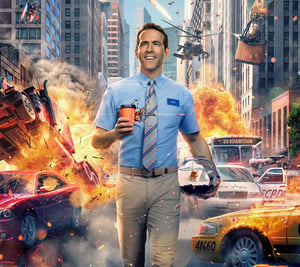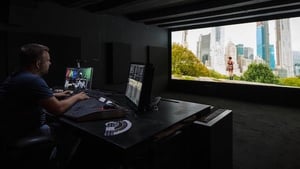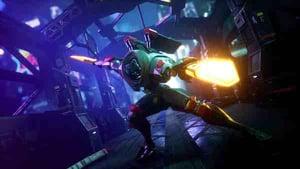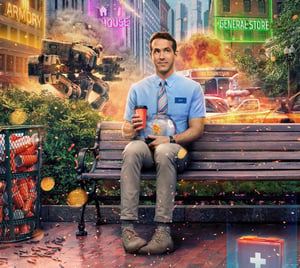
cineSync keeps collaboration secure on Free Guy
From the moment he read the script, VFX Producer Viet Luu knew working on Free Guy would be a unique experience.
Free Guy, starring Ryan Reynolds, Jodie Comer and Taika Waititi, revolves around the tale of a bank teller who discovers he’s a non-player character inside a brutal, open-world video game. For Viet and his team, this meant building a hyperreal, kaleidoscopic, neon-tinted RPG game world full of all the things one might expect of such an environment—explosions, rocket launchers, and fighter jets storming through busy city intersections.
Below, Viet reveals how he and his team worked to create Free Guy’s extraordinary video game aesthetic and plant Ryan Reynolds within a simulated virtual cityscape—and how cineSync helped the team collaborate during the upheaval of lockdown.
Building worlds
Bringing Free Guy’s fantastical story to life required the collaboration of multiple vendors, including Digital Domain, Lola Visual Effects, Mammal Studios, Raynault VFX, and Scanline VFX. All involved worked closely to deliver on the creative vision of director Shawn Levy, including building the multiple distinct universes featured throughout the film.
“The majority of production took place in Boston—this was our backdrop for the RPG world as seen from Ryan’s character’s perspective,” says Viet. “We aimed to create visual effects that were very much grounded in reality. After all, for Ryan’s character, this world is real, so even large set pieces with explosions or chase sequences had to look like live-action.”
To maintain this natural feel within the RPG universe, the visual effects team created high-resolution digi-doubles of many actors. The USC Institute for Creative Technologies helped scan actors’ facial performances, followed by a shoot to track all other movements on a motion capture stage. The result of this footage became Free Guy’s video game universe, as seen from the perspective of real-world players who interact with the game from the comfort of their couches and gaming chairs.
“We’d shoot a scene practically, then go back and recreate it in CG with the help of our motion capture data,” says Viet. “We were refining hyper-real visual effects shots for our realistic world and creating our video game world from scratch. Depending on the scene, we’d think about whether the world should look more like an anime or something like Call of Duty. The process was challenging but super fun.
“Luckily, cineSync was a lifeline when refining multiple creative ideas.”

Leveling up with cineSync
As Viet was working with vendors worldwide, communication via cineSync became vital. “When you’re not physically in the same space, it can be challenging to reference an element in your image, especially when it’s a small detail like hair on a character’s head,” says Viet.
“Thankfully, cineSync’s drawing tools gave the VFX leadership team so much more control. I could write notes or draw directly on the frame and flesh out concepts in sync with our art director and production designers, knowing cineSync saved all those edits. Afterward, I’d do a quick export and have access to every drawing and note from the session. I’d take those annotated frames and send them to each vendor ahead of our weekly reviews. The process was super easy and kept everyone synced.”
cineSync also enabled the Free Guy visual effects team to transform their workflow when lockdown hit in 2020.
“We had just done some additional reshoots in Los Angeles, and we were about to go to Hong Kong, France, Russia, and New York to lens a few more ideas we’d had,” Viet recalls. “We were also set to complete a final facial capture session with Ryan in Atlanta, where he was shooting for another movie. Then COVID-19 canceled everything. The industry shut down.”
The industry went into hyperdrive to ensure the safety of artists. Creatives flocked to work from their home offices as studios established new processes for remote work. cineSync played a big part in the transition, as Viet explains. “Although we were already using cineSync for vendor reviews, cineSync enabled us to remain truly connected when everyone began working from home. We began using cineSync to share work and give feedback for everything we did. All director reviews, editor reviews, you name it; it all moved to cineSync.”
"Automatic media downloads in cineSync is a great feature—it eliminates the time-consuming admin involved in gathering media ahead of a review session."
Viet Luu
VFX Producer

Share and share alike (securely)
Naturally, one big reservation around remote workflows has centred on the security of content. Thankfully, cineSync’s media management solutions ensured the complete safety of all content shared.
“Typically, I would use Aspera to send media files to participants ahead of a review session and make sure everyone was looking at the same updated frames. However, what’s great about cineSync is that all you have to do is send your review session key to the recipient; they access the review via the session key and all the required files for review are automatically downloaded into their temp folder. Then, when your collaborator exits the session, cineSync automatically deletes all media from their drive (if you tell cineSync to do so). The whole process is super simple.
“Automatic media downloads in cineSync is a great feature that eliminates the time-consuming admin involved in gathering media and prepping ahead of a review session. The process is also perfect for security, given that cineSync not only auto deletes the content but ensures it is fully encrypted and playable only in cineSync the entire time it is shared.
“Thanks to secure time-savers like this, we were able to get Free Guy back on track. cineSync was key: we depended on it to finish the film.”
Try Cinesync today
Dive in with Cinesync and give life to your ideas. (Or just have fun doodling on an asset!)
More customer success stories







